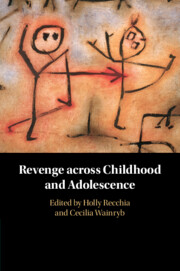Book contents
- Revenge across Childhood and Adolescence
- Revenge across Childhood and Adolescence
- Copyright page
- Dedication
- Contents
- Figures
- Tables
- Contributors
- Acknowledgments
- Chapter 1 And If You Wrong Us, Shall We Not Revenge?
- Chapter 2 A Framework for Understanding Variation in Youth Revenge Motivations and Retaliatory Behaviors
- Chapter 3 Normative Changes and Individual Differences in Retaliation Judgments
- Chapter 4 Developing Revenge in Early Childhood
- Chapter 5 Understanding Youths’ Retaliatory Experiences through the Lens of Moral Agency
- Chapter 6 Cultural Systems and the Development of Norms Governing Revenge and Retribution
- Chapter 7 Settling the Score in a Zero-Sum Game
- Chapter 8 Intergroup Processes
- Chapter 9 Revenge, Justice Systems, and Institutional Trust in Schools
- Chapter 10 The Importance of a Positive School Climate in Addressing Youth Retaliation
- Chapter 11 Socioemotional Competencies and Positive Classroom Climate as Alternatives to Prevent Revenge in Colombian Schools
- Chapter 12 Looking Back and Charting a Course
- Index
- References
Chapter 10 - The Importance of a Positive School Climate in Addressing Youth Retaliation
Published online by Cambridge University Press: 08 July 2021
- Revenge across Childhood and Adolescence
- Revenge across Childhood and Adolescence
- Copyright page
- Dedication
- Contents
- Figures
- Tables
- Contributors
- Acknowledgments
- Chapter 1 And If You Wrong Us, Shall We Not Revenge?
- Chapter 2 A Framework for Understanding Variation in Youth Revenge Motivations and Retaliatory Behaviors
- Chapter 3 Normative Changes and Individual Differences in Retaliation Judgments
- Chapter 4 Developing Revenge in Early Childhood
- Chapter 5 Understanding Youths’ Retaliatory Experiences through the Lens of Moral Agency
- Chapter 6 Cultural Systems and the Development of Norms Governing Revenge and Retribution
- Chapter 7 Settling the Score in a Zero-Sum Game
- Chapter 8 Intergroup Processes
- Chapter 9 Revenge, Justice Systems, and Institutional Trust in Schools
- Chapter 10 The Importance of a Positive School Climate in Addressing Youth Retaliation
- Chapter 11 Socioemotional Competencies and Positive Classroom Climate as Alternatives to Prevent Revenge in Colombian Schools
- Chapter 12 Looking Back and Charting a Course
- Index
- References
Summary
Authoritarian and retributive discipline policies that characterize the crime control model of school discipline feed into a cycle of harm whereby aggressive behaviors, including retribution and revenge, are likely to be reinforced as normative responses to an unjust and unequal environment. These policies are ineffective at reducing violence and delinquency, can result in poor academic outcomes, are disproportionately applied, and have negative impacts on the school climate. They also fail to capture the importance of teaching students the social and behavioral skills that are associated with better academic and behavioral outcomes. By contrast, the school climate is an important malleable component that can have positive impacts on a variety of outcomes. Whole school approaches to positive discipline such as Positive Behavioral Interventions and Supports and Restorative Justice are far more promising policies to improving the school climate and associated student outcomes, including retaliatory behavior.
Keywords
- Type
- Chapter
- Information
- Revenge across Childhood and Adolescence , pp. 247 - 270Publisher: Cambridge University PressPrint publication year: 2021
References
- 1
- Cited by



